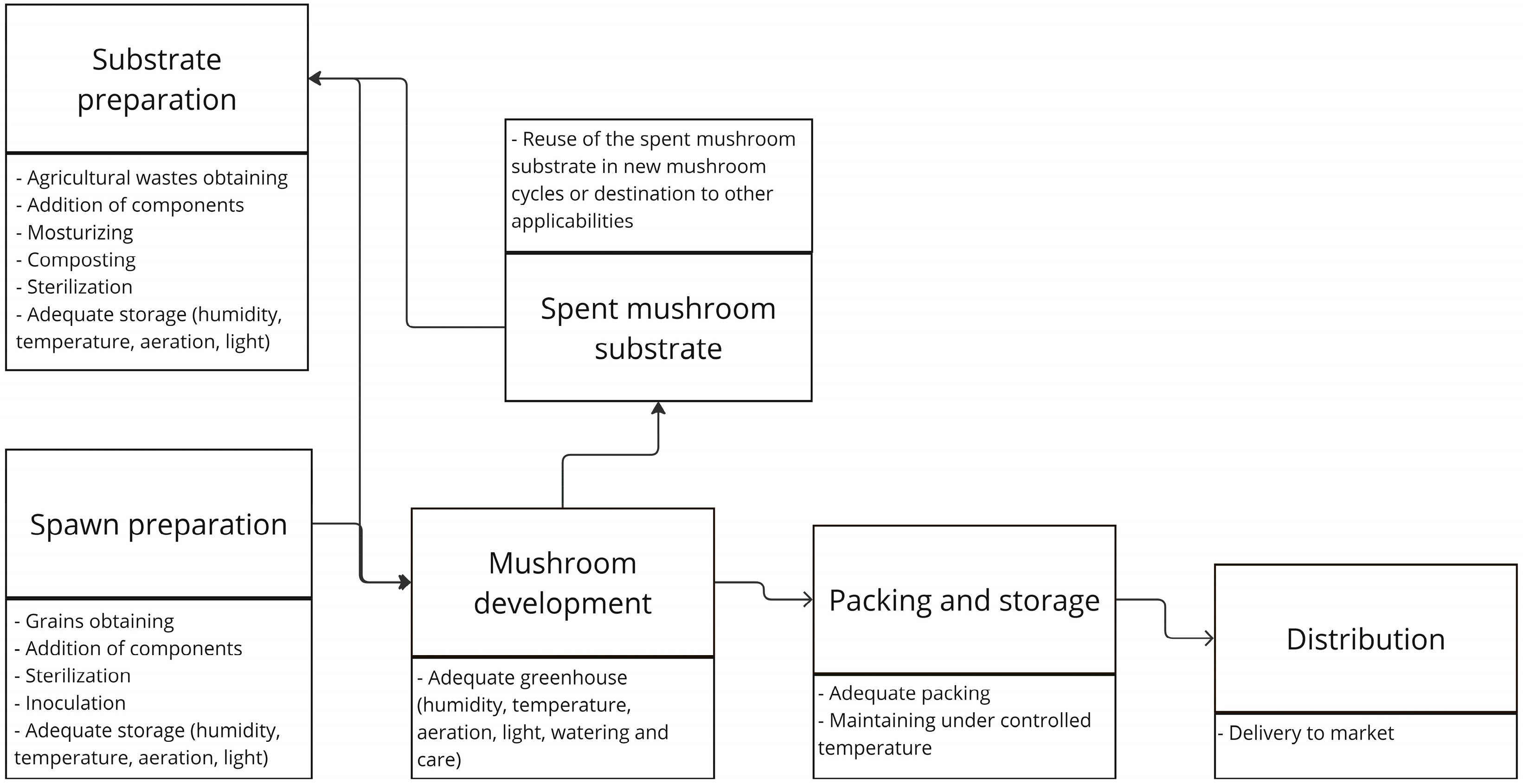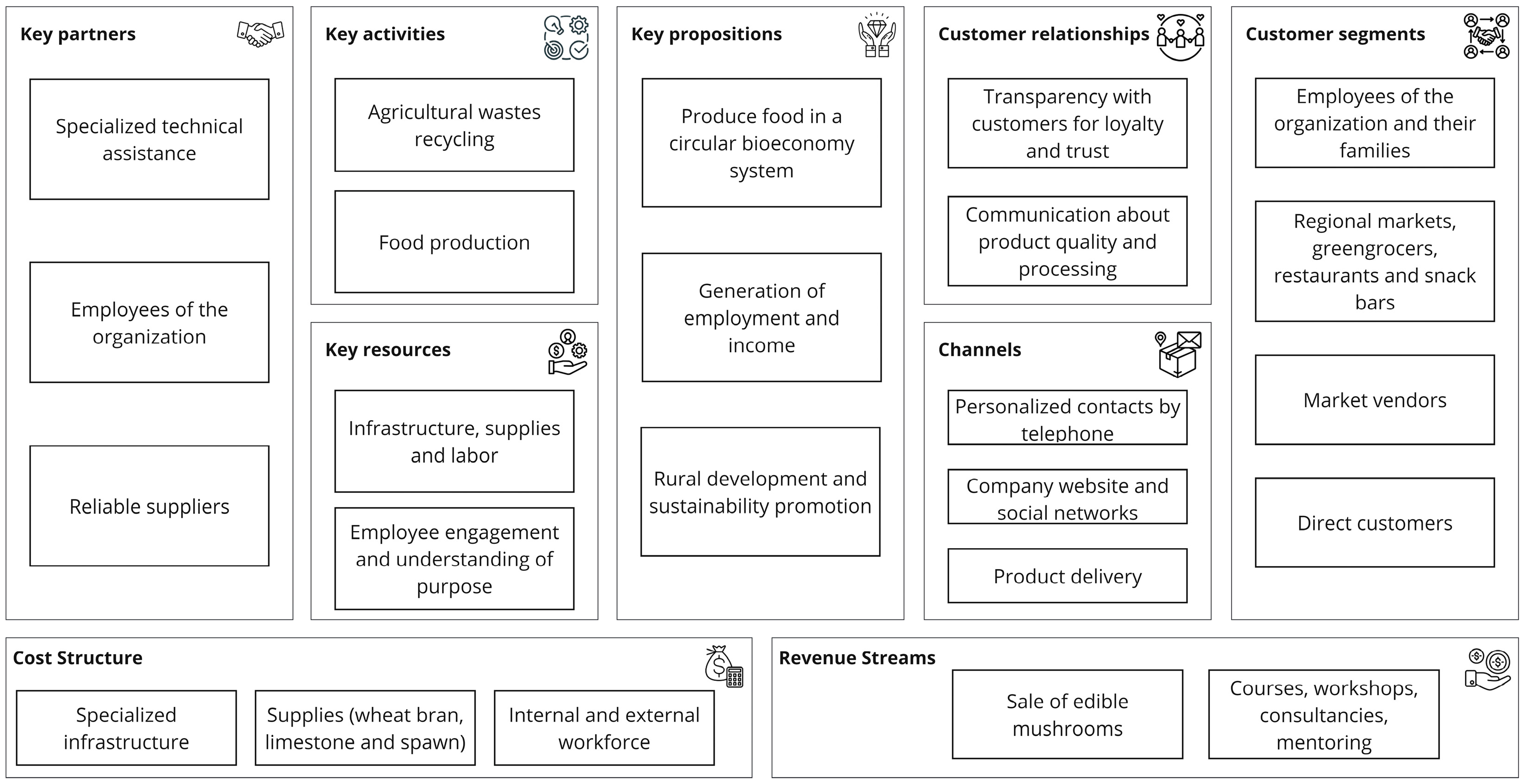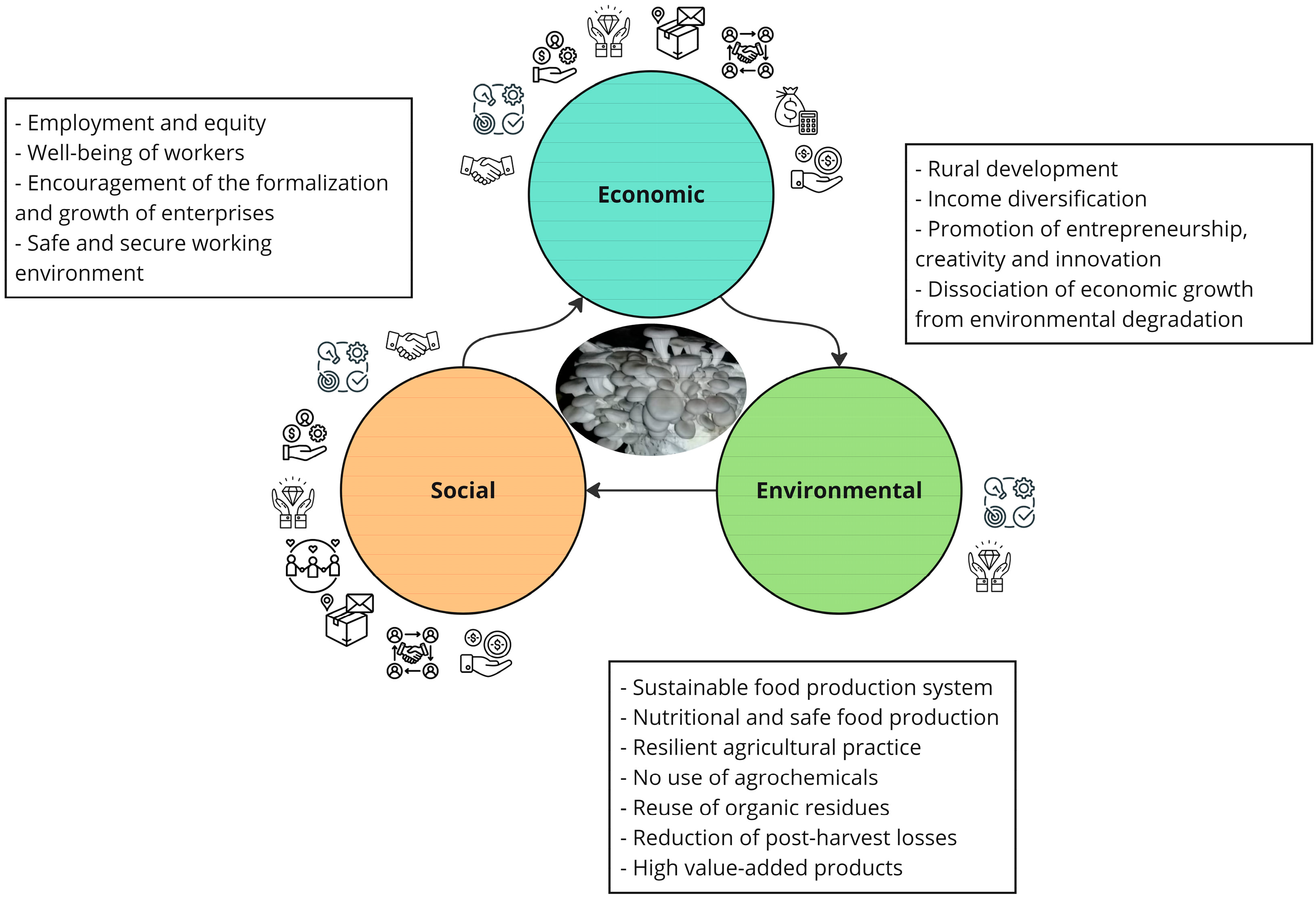A Business Model for Circular Bioeconomy: Edible Mushroom Production and Its Alignment with the Sustainable Development Goals (SDGs)
Abstract
:1. Agricultural Wastes
2. Circular Bioeconomy
3. Edible Mushrooms
4. Business Model Canvas (BMC)
5. Business Model for Mushroom Production
6. Sustainable Development Goals (SDGs)
7. Discussion
8. Conclusions
Author Contributions
Funding
Data Availability Statement
Acknowledgments
Conflicts of Interest
References
- FAO. The Impact of Disasters and Crises on Agriculture and Food Security; FAO: Rome, Italy, 2021. [Google Scholar] [CrossRef]
- Gupta, J.; Kumari, M.; Mishra, A.; Swati; Akram, M.; Thakur, I.S. Agro-forestry waste management-A review. Chemosphere 2022, 287, 132321. [Google Scholar] [CrossRef] [PubMed]
- Siqueira, M.U.; Contin, B.; Fernandes, P.R.B.; Ruschel-Soares, R.; Siqueira, P.U.; Baruque-Ramos, J. Brazilian Agro-industrial Wastes as Potential Textile and Other Raw Materials: A Sustainable Approach. Mater. Circ. Econ. 2022, 4, 9. [Google Scholar] [CrossRef]
- Duque-Acevedo, M.; Belmonte-Ureña, L.J.; Cortés-García, F.J.; Camacho-Ferre, F. Agricultural waste: Review of the evolution, approaches and perspectives on alternative uses. Glob. Ecol. Conserv. 2020, 22, e00902. [Google Scholar] [CrossRef]
- Koul, B.; Yakoob, M.; Shah, M.P. Agricultural waste management strategies for environmental sustainability. Environ. Res. 2022, 206, 112285. [Google Scholar] [CrossRef] [PubMed]
- Ellen MacArthur Foundation. What Is a Circular Economy? 2019. Available online: https://www.ellenmacarthurfoundation.org/circular-economy/concept (accessed on 12 June 2024).
- Cucciniello, R.; Cespi, D. Recycling within the Chemical Industry: The Circular Economy Era. Recycling 2018, 3, 22. [Google Scholar] [CrossRef]
- Stegmann, P.; Londo, M.; Junginger, M. The circular bioeconomy: Its elements and role in European bioeconomy clusters. Resour. Conserv. Recycl. X 2020, 6, 100029. [Google Scholar] [CrossRef]
- Tan, E.C.D.; Lamers, P. Circular Bioeconomy Concepts—A Perspective. Front. Sustain. 2021, 2, 701509. [Google Scholar] [CrossRef]
- Brandão, A.S.; Gonçalves, A.; Santos, J.M.R.C.A. Circular bioeconomy strategies: From scientific research to commercially viable products. J. Clean. Prod. 2021, 295, 126407. [Google Scholar] [CrossRef]
- Brandão, A.S.; Santos, J.M.R.C.A. Rural regions as key locations for the Circular Bioeconomy: Insights from the northern interior of Portugal. Bioresour. Technol. Rep. 2022, 17, 100955. [Google Scholar] [CrossRef]
- Stamets, P. Growing Gourmet and Medicinal Mushrooms; Ten Speed Press: Berkeley, CA, USA, 2011. [Google Scholar]
- Royse, D.J.; Baars, J.; Tan, Q. Current Overview of Mushroom Production in the World. In Edible and Medicinal Mushrooms; Zied, D.C., Pardo-Giménez, A., Eds.; John Wiley & Sons Ltd.: Hoboken, NJ, USA, 2017; pp. 5–13. [Google Scholar] [CrossRef]
- FAOSTAT. 2023. Available online: https://www.fao.org/faostat/en/#data/QCL (accessed on 14 June 2024).
- Thakur, M.P. Advances in mushroom production: Key to food, nutritional and employment security: A review. Indian Phytopathol. 2020, 73, 377–395. [Google Scholar] [CrossRef]
- Girmay, Z.; Gorems, W.; Birhanu, G.; Zewdie, S. Growth and yield performance of Pleurotus ostreatus (Jacq. Fr.) Kumm (oyster mushroom) on different substrates. AMB Express 2016, 6, 87. [Google Scholar] [CrossRef] [PubMed]
- Masevhe, M.R.; Soundy, P.; Taylor, N.J. Alternative substrates for cultivating oyster mushrooms (Pleurotus ostreatus). S. Afr. J. Plant Soil 2015, 33, 97–103. [Google Scholar] [CrossRef]
- Yamauchi, M.; Sakamoto, M.; Yamada, M.; Hara, H.; Taib, S.M.; Rezania, S.; Din, M.F.M.; Hanafi, F.H.m. Cultivation of oyster mushroom (Pleurotus ostreatus) on fermented moso bamboo sawdust. J. King Saud Univ. Sci. 2019, 31, 490–494. [Google Scholar] [CrossRef]
- Viriato, V.; Mäkelä, M.R.; Kowalczyk, J.E.; Ballarin, C.S.; Loiola, P.P.; Andrade, M.C.N. Organic residues from agricultural and forest companies in Brazil as useful substrates for cultivation of the edible mushroom Pleurotus ostreatus. Lett. Appl. Microbiol. 2022, 74, 44–52. [Google Scholar] [CrossRef] [PubMed]
- Chang, S.; Wasser, S. The Cultivation and Environmental Impact of Mushrooms. Oxford Research Encyclopedia of Environmental Science. 2017, pp. 1–38. Available online: https://oxfordre.com/environmentalscience/display/10.1093/acrefore/9780199389414.001.0001/acrefore-9780199389414-e-231 (accessed on 28 May 2024).
- Valverde, M.E.; Hernández-Pérez, T.; Paredes-López, O. Edible mushrooms: Improving human health and promoting quality life. Int. J. Microbiol. 2015, 2015, 376387. [Google Scholar] [CrossRef] [PubMed]
- Dorr, E.; Koegler, M.; Gabrielle, B.; Aubry, C. Life cycle assessment of a circular, urban mushroom farm. J. Clean. Prod. 2021, 288, 125668. [Google Scholar] [CrossRef]
- Zied, D.C.; Sánchez, J.E.; Noble, R.; Pardo-Giménez, A. Use of Spent Mushroom Substrate in New Mushroom Crops to Promote the Transition towards A Circular Economy. Agronomy 2020, 10, 1239. [Google Scholar] [CrossRef]
- De Cianni, R.; Varese, G.C.; Mancuso, T. A Further Step toward Sustainable Development: The Case of the Edible Mushroom Supply Chain. Foods 2023, 12, 3433. [Google Scholar] [CrossRef]
- Osterwalder, A.; Pigneur, Y. Business Model Generation: A Handbook for Visionaries, Game Changers, and Challengers; Wiley: Hoboken, NJ, USA, 2010. [Google Scholar]
- Sparviero, S. The Case for a Socially Oriented Business Model Canvas: The Social Enterprise Model Canvas. J. Soc. Entrep. 2019, 10, 232–251. [Google Scholar] [CrossRef]
- Trimi, S.; Berbegal-Mirabent, J. Business model innovation in entrepreneurship. Int. Entrep. Manag. J. 2012, 8, 449–465. [Google Scholar] [CrossRef]
- Joyce, A.; Paquin, R.L. The triple layered business model canvas: A tool to design more sustainable business models. J. Clean. Prod. 2016, 135, 1474–1486. [Google Scholar] [CrossRef]
- Gontard, N.; Sonesson, U.; Birkved, M.; Majone, M.; Bolzonella, D.; Celli, A.; Angellier-Coussy, H.; Jang, G.; Verniquet, A.; Broeze, J.; et al. A research challenge vision regarding management of agricultural waste in a circular bio-based economy. Crit. Rev. Environ. Sci. Technol. 2018, 48, 614–654. [Google Scholar] [CrossRef]
- Miles, P.G.; Chang, S.-T. Mushrooms: Cultivation, Nutritional Value, Medicinal Effect, and Environmental Impact, 2nd ed.; CRC Press: Boca Raton, FL, USA, 2004. [Google Scholar] [CrossRef]
- Bellettini, M.B.; Fiorda, F.A.; Maieves, H.A.; Teixeira, G.L.; Ávila, S.; Hornung, P.S.; Júnior, A.M.; Ribani, R.H. Factors affecting mushroom Pleurotus spp. Saudi J. Biol. Sci. 2019, 26, 633–646. [Google Scholar] [CrossRef]
- Griggs, D.; Stafford-Smith, M.; Gaffney, O.; Rockström, J.; Öhman, M.C.; Shyamsundar, P.; Steffen, W.; Glaser, G.; Kanie, N.; Noble, I. Sustainable development goals for people and planet. Nature 2013, 495, 305–307. [Google Scholar] [CrossRef] [PubMed]
- Kapahi, M. Recent Advances in Cultivation of Edible Mushrooms. In Biology of Macrofungi. Fungal Biology; Springer: Cham, Switzerland, 2018; pp. 275–286. [Google Scholar] [CrossRef]
- Silva, N.; Tolfo, S.R. Trabalho significativo e felicidade humana: Explorando aproximações. Rev. Psicol. Organ. E Trab. 2012, 12, 341–354. Available online: http://pepsic.bvsalud.org/scielo.php?script=sci_arttext&pid=S1984-66572012000300008&lng=pt&tlng=pt (accessed on 24 May 2024).
- Mwango, A.; Kambole, C. Engineering Characteristics and Potential Increased Utilisation of Sawdust Composites in Construction—A Review. J. Build. Constr. Plan. Res. 2019, 7, 59–88. [Google Scholar] [CrossRef]
- Malhi, G.S.; Kaur, M.; Kaushik, P. Impact of climate change on agriculture and its mitigation strategies: A review. Sustainability 2021, 13, 1318. [Google Scholar] [CrossRef]
- Marques, V. Marketing Digital de A a Z. Digital 360. 2022. Available online: https://books.google.com.br/books?hl=pt-BR&lr=&id=_cgQEAAAQBAJ (accessed on 23 May 2024).
- Bononi, V.L.; Capelari, M.; Maziero, R.; Trufem, S.F.B. Cultivo de Cogumelos Comestíveis; Ícone: São Paulo, Brasil, 1995. [Google Scholar]
- Roos, A.; Becker, E.L.S. Educação ambiental e sustentabilidade. Rev. Eletrônica Em Gestão Educ. E Tecnol. Ambient. 2012, 5, 857–866. [Google Scholar] [CrossRef]
- Fonseca, L.M.; Domingues, J.P.; Dima, A.M. Mapping the Sustainable Development Goals Relationships. Sustainability 2020, 12, 3359. [Google Scholar] [CrossRef]
- Dhar, B.L. Mushroom Farm Design and Technology of Cultivation. In Edible and Medicinal Mushrooms; Zied, D.C., Pardo-Giménez, A., Eds.; John Wiley & Sons Ltd.: Hoboken, NJ, USA, 2017; pp. 271–308. [Google Scholar] [CrossRef]
- Grimm, D.; Kuenz, A.; Rahmann, G. Integration of mushroom production into circular food chains. Org. Agric. 2021, 11, 309–317. [Google Scholar] [CrossRef]
- Thorenz, A.; Wietschel, L.; Stindt, D.; Tuma, A. Assessment of agroforestry residue potentials for the bioeconomy in the European Union. J. Clean. Prod. 2018, 176, 348–359. [Google Scholar] [CrossRef]
- Leong, Y.K.; Ma, T.; Chang, J.; Yang, F. Recent advances and future directions on the valorization of spent mushroom substrate (SMS): A review. Bioresour. Technol. 2022, 344, 126157. [Google Scholar] [CrossRef]
- Okuda, Y. Sustainability perspectives for future continuity of mushroom production: The bright and dark sides. Front. Sustain. Food Syst. 2022, 6, 1026508. [Google Scholar] [CrossRef]
- Stahel, W. The circular economy. Nature 2016, 531, 435–438. [Google Scholar] [CrossRef]
- Schaltegger, S.; Lüdeke-Freund, F.; Hansen, E.G. Business Models for Sustainability: A Co-Evolutionary Analysis of Sustainable Entrepreneurship, Innovation, and Transformation. Organ. Environ. 2016, 29, 264–289. [Google Scholar] [CrossRef]
- Rosati, F.; Rodrigues, V.P.; Cosenz, F.; Li-Ying, J. Business model innovation for the Sustainable Development Goals. Bus. Strategy Environ. 2022, 32, 3752–3765. [Google Scholar] [CrossRef]
- Fakieh, B.; AL-Ghamdi, A.S.A.; Ragab, M. The Effect of Utilizing Business Model Canvas on the Satisfaction of Operating Electronic Business. Complexity 2022, 2022, 1649160. [Google Scholar] [CrossRef]
- Nezlek, J.B.; Forestell, C.A. Vegetarianism as a social identity. Curr. Opin. Food Sci. 2020, 33, 45–51. [Google Scholar] [CrossRef]
- Li, C.; Xu, S. Edible mushroom industry in China: Current state and perspectives. Appl. Microbiol. Biotechnol. 2022, 106, 3949–3955. [Google Scholar] [CrossRef]
- Camacho-Otero, J.; Boks, C.; Pettersen, I.N. Consumption in the Circular Economy: A Literature Review. Sustainability 2018, 10, 2758. [Google Scholar] [CrossRef]



| Key Elements | Description |
|---|---|
| Key partners | Identification of all partners involved in the manufacturing process of the product or provision of the service as a whole, who participate from raw material acquisition to product delivery. |
| Key activities | Activities that must be carried out by the organization for the customer value proposition to be achieved and for the business model to function. |
| Key resources | The most important assets required by the business model. Resources enable the enterprise to create and offer a value proposition, reach markets, maintain relationships with customer segments, and generate revenue. These resources can be physical, financial, intellectual, or human. |
| Value propositions | It corresponds not only to customer satisfaction with the product or service provided but also to differentiation or authentic characteristics that set them apart from competitors’ products or services. This creates value for a specific customer segment. |
| Customer relationships | Types of relationships that the company establishes with a specific customer segment. The company should clarify the type of relationship that it will maintain with each customer, considering their particularities and needs, which can range from personal to automated relationships. |
| Customer segments | Definitions of the different groups of individuals or organizations that the enterprise aims to reach and serve. To better satisfy them, the company should divide customers into groups according to their distinct segments, such as common needs, behaviors, and other relevant attributes. |
| Channels | The organization’s manner of communicating with customer segments to deliver the value proposition. Communication, distribution, and sales channels comprise the company’s interface with the purchaser, representing an important role in the customer experience. |
| Cost structure | Encompasses all costs generated by the operation of the business model, which can vary depending on the model and its scale, and can be easily calculated based on key resources, key activities, and key partners. |
| Revenue streams | It represents the monetary value that the company generates from each customer segment, which can vary among purchasers. The business model may involve two types of revenue: one-time payments from the customer or continuous payments based on the delivery of the value proposition to customers. |
Disclaimer/Publisher’s Note: The statements, opinions and data contained in all publications are solely those of the individual author(s) and contributor(s) and not of MDPI and/or the editor(s). MDPI and/or the editor(s) disclaim responsibility for any injury to people or property resulting from any ideas, methods, instructions or products referred to in the content. |
© 2024 by the authors. Licensee MDPI, Basel, Switzerland. This article is an open access article distributed under the terms and conditions of the Creative Commons Attribution (CC BY) license (https://creativecommons.org/licenses/by/4.0/).
Share and Cite
Viriato, V.; Carvalho, S.A.D.d.; Santoro, B.d.L.; Bonfim, F.P.G. A Business Model for Circular Bioeconomy: Edible Mushroom Production and Its Alignment with the Sustainable Development Goals (SDGs). Recycling 2024, 9, 68. https://doi.org/10.3390/recycling9040068
Viriato V, Carvalho SADd, Santoro BdL, Bonfim FPG. A Business Model for Circular Bioeconomy: Edible Mushroom Production and Its Alignment with the Sustainable Development Goals (SDGs). Recycling. 2024; 9(4):68. https://doi.org/10.3390/recycling9040068
Chicago/Turabian StyleViriato, Viviany, Silvia Angélica Domingues de Carvalho, Bruno de Lima Santoro, and Filipe Pereira Giardini Bonfim. 2024. "A Business Model for Circular Bioeconomy: Edible Mushroom Production and Its Alignment with the Sustainable Development Goals (SDGs)" Recycling 9, no. 4: 68. https://doi.org/10.3390/recycling9040068
APA StyleViriato, V., Carvalho, S. A. D. d., Santoro, B. d. L., & Bonfim, F. P. G. (2024). A Business Model for Circular Bioeconomy: Edible Mushroom Production and Its Alignment with the Sustainable Development Goals (SDGs). Recycling, 9(4), 68. https://doi.org/10.3390/recycling9040068






